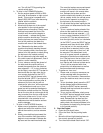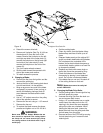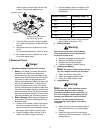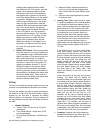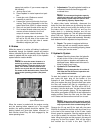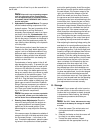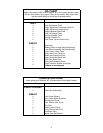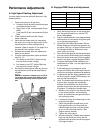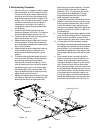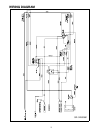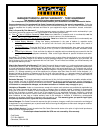22
spray paint. Brush a rust preventive oil on
any unpainted surfaces including the pul-
leys and blades. (Be careful not to get any
oil on the drive belts.)
d. Lubricate the mower.
e. Drain the engine oil. The engine should be
warm so that all the oil drains. Replace the
engine oil filter and refill the crankcase with
fresh oil.
f. Gasoline Engine: Drain all the fuel. Close
the fuel tank shutoff valve. Disconnect the
fuel line from the carbuetor and put the end
into an approved fuel container. Open the
fuel tank shutoff valve and drain the fuel
tank and line into the approved container.
Replace the fuel line on the carburetor.
Start the engine and allow it to run out of
fuel. This will prevent gum and varnish
deposits from forming. Replace the fuel fil-
ter.
g. Gasoline Engine Only: Remove the spark
plugs and pour approximately one ounce
of oil into each cylinder. Crank the engine
one or two turns to spread the oil evenly on
the cylinder walls. Replace the spark
plugs.
h. Disconnect, clean and make sure the bat-
tery is fully charged.
i. Inspect the hydraulic hoses, lines and fit-
tings. Replace as necessary.
j. Jack the mower up and store it on blocks to
take the weight off of the tires.
2. To Put the Mower Back in Service:
a. Check the battery. Charge if necessary.
b. Gasoline Engine Only: Remove the spark
plugs and wipe them off. Using the starter,
crank the engine to pump the excess oil
out of the spark plug holes. Replace the
spark plugs and the ignition leads. Refill
the fuel tank with fresh gasoline.
c. Check the level of the oil in the crankcase
and the hydraulic tank.
d. Lower the mower off the block and check
the tire pressure.
e. Push the mower outdoors and start the
engine. Let the engine idle until it has
warmed up completely (4 to 5 minutes).
MAINTENANCE SCHEDULE
A. Daily Checks
1. Before starting engine:
a. Check the fuel level.**
b. Check the engine oil level.**
c. Check the hydraulic oil level.
d. Check the hydraulic hoses for leaks, abra-
sion, kinks, twists, or a flattened condition.
e. Check the tires and tire pressure.
Drive Tires: 8-10 psi.
Front Caster Wheels: 20-25 psi.
f. Check the spindle belt, the mower drive
belt and the hydro drive belt.
g. Check the blades. Make sure they are
sharp and that the blade securing cap
screws are tight.
h. Check the cutting height.
2. When ready to start the engine:
a. Check the five safety switches for proper
operation.
3. After mowing:
a. Clean the mower.
b. Clean the engine air screen.
c. Oil the wear points. Follow the Oiling
Chart.
d. After the first five hours, Change the
engine oil and engine oil filter.
B. Every 25 Hour Checks
1. Service the engine foam element air pre-
cleaner.*
2. Grease the three spindle bearings.
C. Weekly or Every 50 Hour Checks
1. Change the engine oil. (Every 25 hours under
heavy duty operation.)
2. Clean or replace the engine’s paper air
cleaner element.*
3. Check the battery’s electrolyte level.
4. Clean the engine cooling fins and external
surfaces.*
5. After the first 50 hours, change the hydraulic
oil and the hydraulic oil filter. Change them
every 500 hours thereafter.
6. Oil wear points.
Follow the Oiling Chart.
7. Lubricate all grease fittings.
Follow the
Lubrication Chart.
D. Every 100 Hour Checks
1. Change the engine oil filter. (Every 50 hours
under heavy duty operation.)
2. Check the engine spark plugs.
3. BBC (PTO Clutch) air gap should not exceed
0.025”, if so, adjust as follows:
Ogura JD08, DX-11, GT-1A, GT-2, GT-2.5,
adjust to 0.012" - 0.015"
Ogura GT-3, GT3.5, adjust to 0.015" - 0.022"
E. Yearly Checks
Check the oil in the hydraulic reservoir.
* Perform maintenance more frequently under dusty
conditions.
**Reference Engine Owner’s Manual



